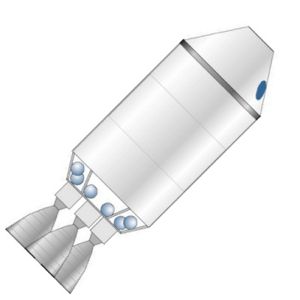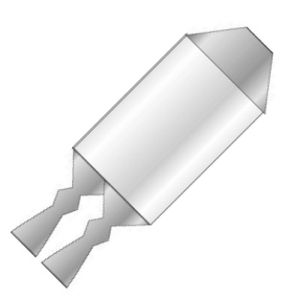
Home - Search - Browse - Alphabetic Index: 0- 1- 2- 3- 4- 5- 6- 7- 8- 9
A- B- C- D- E- F- G- H- I- J- K- L- M- N- O- P- Q- R- S- T- U- V- W- X- Y- Z
CEV Orbital
 CEV Orbital Credit: © Mark Wade |
Status: Study 2012. Height: 14.00 m (45.00 ft). Diameter: 5.00 m (16.40 ft).
Orbital, which had been a lead player on the earlier Orbital Space Plane studies, found itself an outsider in the CEV studies. In January 2005, Orbital joined a Lockheed-led team for the next phase of the CEV down-select. The CEV was no longer part of its long-range business plan. The final Orbital CEV design consisted of:
- Crew Module (CM), which provided habitation for four crew from launch to earth or lunar orbit and return to the Earth's surface. In the lunar scenario the CM would rendezvous and dock with the Lunar Lander in lunar orbit. The CM would operate uncrewed in lunar orbit while the crew was on the moon. The CM also provided the mission's primary communication and navigation assets. The CM would be reusable, use a steerable drogue parachute to allow precision landings on land or water, an phenolic-carbonate ablative re-entry shield, and a tridyne monopropellant reaction control system.
- Space Exploration Module (SEM), which provided LEO insertion capability as well as propulsive capability to transfer the CM or Lunar Lander from LEO to lunar orbit and return to Earth. The SEM also provided additional consumables and power to the CM. This SEM was the only in-space propulsion stage that would have to be designed for the project.
- Launch Abort System (LAS), a tractor rocket system which provided abort capability during boost from the earth up to 60 km altitude, after which the SEM provided high altitude abort capability.
Additional hardware components would be needed for the lunar landing mission:
- Heavy Lift Launch Vehicle (HLLV), which in conjunction with the SEM, provided 141 metric tons lift capability to launch the CEV, Lunar Lander and other mission elements into LEO. This shuttle-derived rocket, consisting of a 5-SSME core, the SEM upper stage, and two five-segment solid rocket boosters, could put 36 metric tons in low lunar orbit.
- Human Lunar Lander (LL), which provided crew habitation from lunar orbit to the lunar surface and return to lunar orbit. The LL also provided surface EVA capability for the crew, and the communication and navigation assets to transfer data/voice/video to other missions assets and the ground. Orbital found a reusable single-stage design the best solution. The LL would be powered by a reusable liquid oxygen/methane rocket engine and be directly applicable to development as a Mars lander using ISRU for fuel generation.
Orbital felt their plan could deliver and return 4 crew to the Moon for about $1.6 billion per mission, significantly less than the Apollo missions, or the $ 2.76 billion of Orbital's mid-term design concept. This amount broke down to $ 864 million in launch costs (2 x $ 432 million), $ 133 million for the CEV re-entry vehicle, $ 542 million for the two SEM upper stages (2 x $ 271 million), and $ 80 million for the lunar lander.
Crew Size: 4.
Family: Lunar Bases, Manned spacecraft, Moon. Country: USA. Agency: NASA, OSC.
 | CEV Orbital Credit: NASA |
 | CEV Orbital Credit: Mark Wade |
Back to top of page
Home - Search - Browse - Alphabetic Index: 0- 1- 2- 3- 4- 5- 6- 7- 8- 9
A- B- C- D- E- F- G- H- I- J- K- L- M- N- O- P- Q- R- S- T- U- V- W- X- Y- Z
© 1997-2019 Mark Wade - Contact
© / Conditions for Use